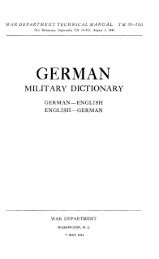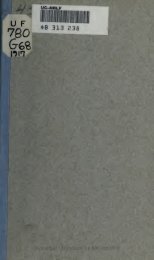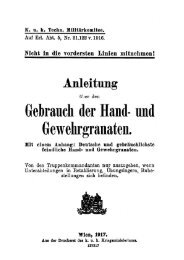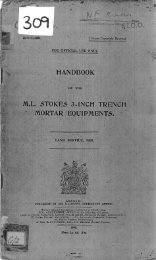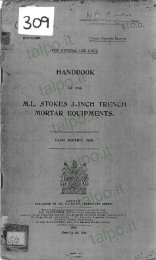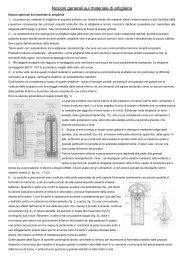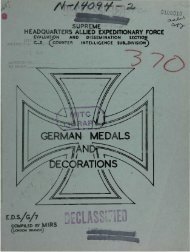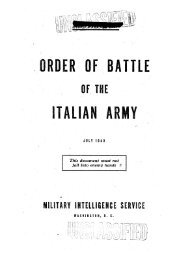- Page 2 and 3:
[S.S. 306.] la/38390. NOTES ON GEKM
- Page 4 and 5:
3 LIST OF GERMAN ARTILLERY FUZES NO
- Page 6 and 7:
5 NAVAL FUZES. PAGE. (a) Percussion
- Page 8 and 9:
- 7 *9 cm. FieldGun (73/88) (9 cm.
- Page 10 and 11:
9 15 cm. Gun with Overhead Shield (
- Page 12 and 13:
11 B.—NAVALGUNS. 37 cm. Trench Gu
- Page 14 and 15:
13 " C— MINENWERFER.' " " " " *(7
- Page 16 and 17:
Distinguishing marks.— 15 Green c
- Page 18 and 19:
17 Abbreviation. Signification. Eng
- Page 20 and 21:
19 MATERIAL OP GERMAN FUZES. The ma
- Page 22 and 23:
21 37 cm. Gr. Z
- Page 24 and 25:
23 5 cm. Gr. Z Scale 9/10 approx
- Page 26 and 27:
25 K.Z.14 n.A.
- Page 28 and 29:
27 L.K.Z.16 o.V. L.K.Z.16 m.V. a_ :
- Page 31 and 32:
30 Designation- — E.K.Z. 16 = Emp
- Page 33:
32 Designation. — E.K.Z. 16 C. =
- Page 37:
— Designation. (?) — Used with.
- Page 40 and 41:
39 »
- Page 42:
41 •
- Page 46 and 47:
45 y
- Page 49:
— 48 Designation. H.Z. 16 = Haubi
- Page 52 and 53:
51 E.H.Z.16 (b 13358) D 2
- Page 54 and 55:
53 E.H.Z.16 C
- Page 56 and 57:
Note. — The letters which the fuz
- Page 58:
K.Z.16 f.lO cm. X
- Page 67:
66 Designation.— = GV. Z.92 fuze
- Page 71 and 72:
70 Designation.— Or. Z. 14 = Gran
- Page 73:
— 72 Designation. — = Gr. Z. Un
- Page 76 and 77:
75 The above is only an approximate
- Page 78:
77 \ V i i \ I y
- Page 81 and 82:
80 \u2666 /
- Page 83:
Designation. — 1910 pattern base
- Page 87:
86 /
- Page 91 and 92:
\u25a0 90 TIMTE AND PERCUSSION FUZE
- Page 93 and 94:
92 — Designation. K.Z. 11 Gr.—K
- Page 95 and 96:
94 — Designation. = L.K.Z. 11 Gr,
- Page 98:
97 (B13358) a
- Page 101 and 102:
100
- Page 103 and 104:
102 — Designation. H.Z.05 Gr. 1.8
- Page 105 and 106:
104 — = Designation. HZ. 05 Schr.
- Page 107 and 108:
— 106 Designation. Lg.Zdr.S/22=Le
- Page 109 and 110:
108
- Page 111 and 112:
110 * 6 /
- Page 113 and 114:
112
- Page 115 and 116:
\u2666 114 Designation.— Dopp. Z.
- Page 117 and 118:
116 Designation. — Dopp. Z. 92 f.
- Page 119 and 120:
118 — Designation.— Dopp. Z. 92
- Page 121 and 122:
120 Designation.— Dopp. Z. 92 Ig.
- Page 123:
122 Designation.— Dopp. = Z. 15 D
- Page 127 and 128:
126
- Page 129 and 130:
128
- Page 131 and 132:
130
- Page 133:
132 FUZES FOR UNIVERSAL SHELL. ~ Br
- Page 136 and 137:
135 s
- Page 138 and 139:
137
- Page 140 and 141:
139 (b) Time and Percussion — Fuz
- Page 142 and 143:
141
- Page 144 and 145:
Z. f. 3-7 cm. Spgr
- Page 146 and 147:
145
- Page 148 and 149:
147
- Page 150 and 151:
149
- Page 152 and 153:
151
- Page 154 and 155:
• 153
- Page 156 and 157:
155
- Page 158 and 159:
i 157
- Page 160 and 161: 159 Dopp.Z. S/26 »
- Page 162 and 163: 161
- Page 164 and 165: 163
- Page 166 and 167: 165 •
- Page 168 and 169: 167
- Page 170 and 171: ; 169
- Page 172 and 173: 171 Az. 16 f.I.W.M "*
- Page 174 and 175: 173 _ The drawing shows a delay-act
- Page 176 and 177: 175 * /
- Page 178 and 179: 177 (b 13358) M
- Page 180 and 181: 179 (b 13358) M 2
- Page 182 and 183: 181
- Page 184 and 185: fOjjfG 183 Z.m.W.M. and Z.s.u.m. W.
- Page 187 and 188: Designation. Used with.— — 186
- Page 189 and 190: 188 — vDesignation. Z.gl. W.M. fo
- Page 191 and 192: 190
- Page 193 and 194: 192
- Page 195 and 196: % 194
- Page 197 and 198: Designation.— 196 FRENCH FUZES, F
- Page 199 and 200: 198 — FRENCH FUZE. Designation. F
- Page 201 and 202: 200 — FRENCH FUZE. Designation. F
- Page 203 and 204: \u25a0 •• 202 — FRENCH FUZES.
- Page 205 and 206: 204 — BELGIAN FUZE. Designation.
- Page 207 and 208: 206 BELGIAN FUZE. — Designation.
- Page 209: 208 BELGIAN FUZE. — Designation.
- Page 213 and 214: 212 BELGIAN FUZE. — Designation.
- Page 215 and 216: 214
- Page 217 and 218: 216
- Page 219 and 220: 218 APPENDIX 11. CONVEESION TABLE.



